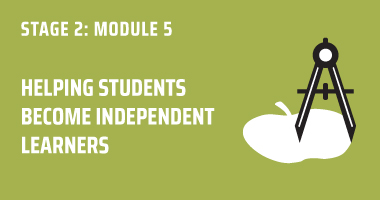Lesson 5 - Dismantling Over-Scaffolding
HELPING STUDENTS BECOME INDEPENDENT LEARNERS
TIMING/TASKS: Video Length 12 minutes. To complete this lesson: 1) Watch video to end; 2) Read additional text below; 3) Download & complete exercise(s) in right column
Dismantling Over-Scaffolding
OUTCOMES
LESSONS IN THIS MODULE
DOWNLOADS FOR THIS MODULE
RESOURCES
EXERCISES
No Exercises this Lesson
I can recognize the difference between scaffolding for access and scaffolding for progress
I can identify those scaffolds that promote dependent learning for marginalized populations
I can fade those scaffolds that unintentionally cultivate learned helplessness rather than academic progress using a gradual release of responsibility
In this module, we have focused on helping all students think differently, act differently, and engage differently in order to get into the learning pit ready and excited about productive struggle. But, in this PLC, we are especially focused those students who have been historically under-served in schools and, as a result, are under-performing academically.
In the past, our focus as equity-minded educators and school districts was about granting all students access to the curriculum and engage all during instruction. This was essential for English learners, those with IEPs, and struggling learners.
Unfortunately, the way in which scaffolding to increase equity through access was implemented resulted in more dependency, not less because of over-scaffolding.
Many of us recognize that we have created learned helplessness in students who came to us with learning gaps. So, we are eager to stop the habit of over-scaffolding immediately, like right now.
Hold it, though. Don’t be too quick to dismantle those scaffolds before students have built some of the minimal capacities outlined in earlier modules in Stage 1 and Stage 2 like reframing errors as information, having instructional conversations with in talk structures that accommodate cultural styles, and using cognitive tools to chew more effectively with cultural learning tools.
As you are building their capacity, slowly you will see that there are certain scaffolds you no longer need. Knowing when and how to dismantle scaffolds begins with understanding the two different types of academic scaffolds – scaffolding for greater access to the content and scaffolding for progress to do deeper learning of the content (stretch).
As an educator focused on disrupting the status quo when it comes to inequity by design, you have to learn the difference between the two. Because as you reduce one or “fade it”, you have to make sure students reach new minimal levels of cognitive independence, beginning with the tools and techniques shared in Module 2 and Module 3.
When it comes to removing a scaffold, fading is the process of gradually removing parts of it over time until it is completely gone. Remember, all students need scaffolds. But a scaffold that stays in place indefinitely becomes a crutch, leading to learned helplessness due to underdeveloped cognitive capacity to carry the cognitive load during instruction.
Instead, we want the dependent learner to internalize the key learning moves and the disposition to become a self-regulated, independent learner.
ACTION ITEMS
Assess how and where you might be over-scaffolding instruction for access and under scaffolding for cognitive stretching.
Select one small scaffold to “fade” or discontinue. Use the checklist to set up a fading time schedule and process.
Help students activate and lean on the social-emotional structures and processes put in place in Module 2 as it might feel scary when larger parts of the scaffold are removed. Additionally, pay attention to your own internal social-emotional equilibrium.
Save to My Content

